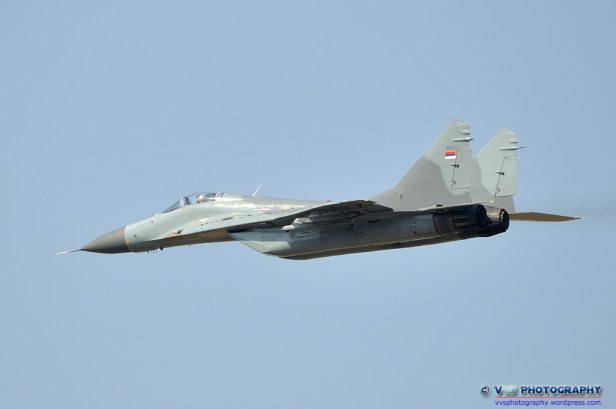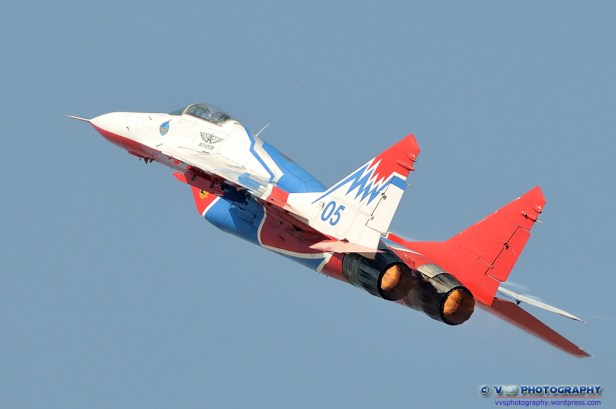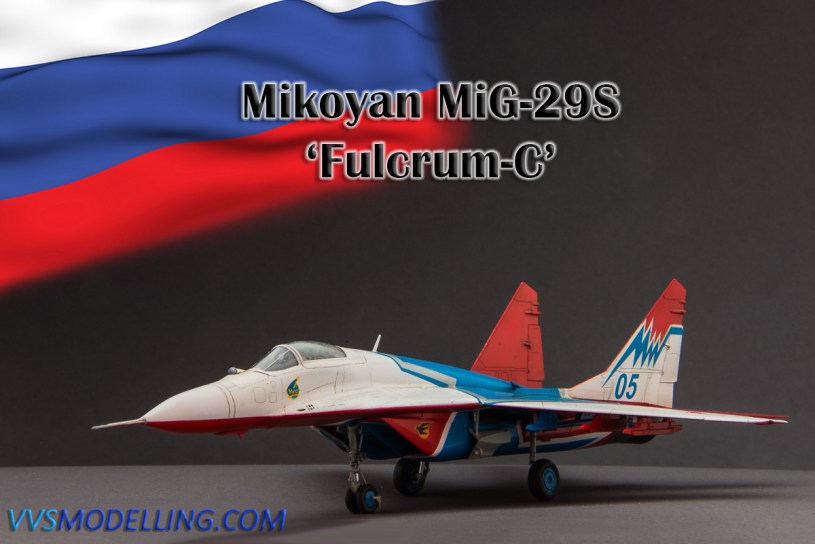Mikoyan MiG-29 doesn’t need a special introduction. One of the most famous (and feared by the West) 4th generation jet fighters in the world, it first flew in 1977 and entered service with Soviet Air Force in 1982. Designed to replace the MiG-23 in Frontal Aviation units, the requirement to operate from rugged, damaged or unprepared runways resulted in reinforced landing gear and anti-FOD measures, including the mudguard and closing jet intakes with auxiliary intakes on the top of leading edge root extension.
First version to be put into service was MiG-29A, which was externally recognized by having small ventral stabilizers (like Su-27 series) and different landing gear and airbrake design. MiG-29B which soon followed was built in more than 800 examples, a lot of them downgraded for export, which are still in use today in many air forces including Serbia, India, Bulgaria, Iran, to name but a few.
The next upgrade that happened in the ’80s was the so called izdeliye 9.13, which is also the subject of this build. MiG-29S 9.13 ‘Fulcrum-C’ introduced an enlarged dorsal hump, which is the most recognizable feature compared to 9.12. 9.13 could carry the longer ranged air-to-air R-27ER missile, the enlarged dorsal hump carries an active radar jammer as well as additional fuel and the airframe strengthening brought the total armament capability to 4.000kg. This version also included an improved flight control system slightly improving maneuverability.

Swifts / Strizhi / Стрижи
The beginnings of aerobatic group Strizhi go back to the late ’80s, when a group of pilots started training in precision formation flying through aerobatic maneuvers with their debut performance on May 6th, 1991 and their international debut a few months later at an airshow in Sweden. In the beginning, the group performed with 9.12 version of MiG-29, painted in white and blue, but later switched to 9.13 and repainted their aircraft into current scheme of red and white with blue swift symbol on top and bottom of the aircraft. UB (9.51) twoseaters were also used in both liveries. Strizhi recently celebrated their 25th anniversary and Zvezda celebrated this event by releasing their new 9.13 kit with Strizhi markings and box artwork.The team is based, like the Russian Knights Flanker equipped team at Kubinka Air Base and usually performs as a 5- or 6-ship while a 4-ship flight usually flies with a 5-ship Russian Knights team during celebrations of special events, like the 9th May parade over the Red Square in Moscow.

The kit
There isn’t much to say to this kit, that I haven’t already said in my previous in-progress threads (PART1, PART2). Despite some small shortcomings, the kit is really a joy to build, is accurate and it’s the first MiG-29 kit in 1:72 that has correctly depicted open jet intakes and closed auxiliary intakes. The later are open only when the aircraft is on ground and the engines are running (from start-up to take-off and from landing to shutting down the engines). The engraved detail is well defined if a bit shallow, mostly on the curved surfaces like LERX. There are no engraved rivets present but I don’t mind that, as they are more often than not over emphasized and don’t look real. With a multitude of riveting tools present today on the market, making you own shouldn’t be a problem. If building the Swifts version, the easiest way of applying the top decals would be to wait with vertical stabilizers installation until after decaling. Decals themselves proved excellent, thin enough and didn’t require any setting solutions. All in all, an excellent kit and I’ll be sure adding a few more to my collection.
Model Data
Company: Zvezda
Scale: 1:72
Aftermarket: none
Paints used: Mr.Paint (MRP-4 White, MRP-45 Dark Blue, MRP-98 Light Gull Grey), Revell (36 Red, enamel)
Alclad (ALC-101 Aluminum, ALC-104 Pale Burnt Metal, ALC-111 Magnesium, ALC-123 Exhaust Manifold, ALC-405 Transparent Smoke, ALC-416 Hotmetal Sepia)






















Awesome job 🙂
Thank you!
Great work on the model Sebastijan, it looks so nice.
Thanks for the kit review and the brief history of the plane.
About the auxiliary intakes , i’ve seen them partial opened in flight. (Polish Mig-29A 65Red at AirplanePictures.net and many other). So i think is not wrong to have them open in flight too. I assume It would be wrong if you have both the auxiliary and the intakes closed.
Keep up the good work.
Hey!
Thank you very much. Yes, indeed, they can be opened in-flight to allow additional flow of air into the engines, particulary in high angle-of-attack manuevers. The problem, however, is that 99% of models are built sitting on the ground and having them open on ground is incorrect.